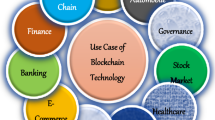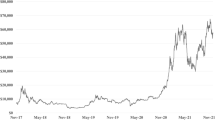Abstract
We conduct a laboratory experiment to explore whether the protection of intellectual property (IP) incentivizes people to create non-rivalrous knowledge goods, foregoing the production of other rivalrous goods. In the contrasting treatment with no IP protection, participants are free to resell and remake non-rivalrous knowledge goods originally created by others. We find that creators reap substantial profits when IP is protected and that rampant pirating is common when there is no IP protection, but IP protection in and of itself is neither necessary nor sufficient for generating wealth from the discovery of knowledge goods. Rather, individual entrepreneurship is the key.
















Similar content being viewed by others
Notes
Our task shares some similarities with the entry decision game by Camerer and Lovallo (1999) in which subjects simultaneously decide whether to take a sure payoff or enter a contest for a prize that decreases in expectation with the number of entrants. When the contest depends on skill, they find excessive entry that appears to be rational on the part of subjects who are overconfident about their own relative skill level. Like ours, their subjects in the trivia contests are not choosing between gambles with known outcome distributions. We do not tell subjects the probability of getting a valuable color in the Studio on a random draw, because the colors they create are not random draws. Finding valuable colors involves both risk and skill.
An edge color is a color which has at most one component valued at 1 or 5.
Our creative task is theoretically similar to that of Ederer and Manso (2013) in that subjects search through a multi-dimensional space. Two important differences are that our search task is presented in the context of creating a new product rather than as a business management decision and that our subjects have an opportunity cost of innovating, so our subjects need to self-select into the innovative task.
In an unreported pilot session, subjects were allowed to post any price they would like. Transaction prices quickly bubbled to as high as 45 cents/unit as subjects attempted to churn units at higher and higher prices. Since we are not interested in studying how price bubbles form for commodities with a known fixed value, we capped the posted prices at the public maximum of 9 cents.
Subjects’ successfully establish verbal trade contracts. While there are accusations of reneging in the chat room, particularly in early days when the participants are exploring the interface, many of the accused contritely apologize for any confusion and some offer to make it up to the offended participant. Crockett et al. (2009) similarly find that reputation and repeated interaction are sufficient for enforcing chat room agreements for the exchange of rivalrous goods.
If there are reasons beyond monetary profit that motivate people to go to the studio, they are equally present in both treatments. No subject made a significant contribution to the color economy who was not earning money from sales of colors.
To do this, a subject must forego any communication in the chat room and postpone all trading until the last 75 seconds of the day.
The usage fee from consuming 18 (19) color goods is 6 (7) cents.
As the experiment designers, we could have specified a probability distribution for returning from the studio with a color good to our subjects in the instructions. We did not do that because a probability distribution is inconsonant with the decision problem of unknowable uncertainty that would-be IP discoverers face in the naturally occurring economy. Modeling a utility maximizing agent who has a small set of pre-defined choices and payoffs would require us to assume away the very problem that we wish to explore.
See Longford (1993) for a description of this technique commonly employed in experimental sciences.
That said, using a Wilcoxon rank sum test to compare all 6 sessions in the IP treatment to all six sessions in No IP treatment, we fail to reject the null hypothesis (U 6,6=24, p-value =0.20, one-sided test).
When asked privately while being paid, “What was your strategy in this experiment?”, IP3-C replied, “Colors baby!” The experimenter followed up by asking, “Why do you think other people were selling the colors they found?” He laughed and replied, “That’s silly.” He found pricing gray to be equally useless. Overall, IP3-C appeared confident that he had made the most of his participation in the experiment.
In day 15, NoIP6-C brags in the chat room that he found the 40¢ color, but that he “just didnt wanna sell it.” NoIP6-G reprimands him with the single word reply of “post”. NoIP6-C never does.
The elements that lead to the free file-sharing culture that we observe on the internet today are not present in this environment. It would be an interesting extension to explore this further, possibly by incorporating the pervasive “us vs. them” mentality of internet pirates toward media companies.
Likewise, in the less related experiment of Wilson et al. (2012).
A movie trailer distributed by the Motion Picture Association of America demonstrates that there is indeed widespread disagreement over the morality of violating intellectual property law. The logic they present, in this order, is:
-
1.
You [the viewer] would not steal a physical object.
-
2.
Pirating movies is “Stealing”.
-
3.
Piracy is prohibited by statutory law.
The trailer concludes with the pronouncement that media piracy is “A Crime”. Understanding the psychological foundations of IP pirating is an interesting avenue to pursue in future research.
-
1.
Galasso and Schankerman (2013) use judges’ decisions and patent citations to determine the effect of patent rights on cumulative innovation. They find that patent rights block innovation only when the patent holders are large firms and the policy implication is ambiguous.
The reason for this mixed design is that we do not know the entrepreneurial potential of a randomly recruited group of new participants. If a No IP group does not produce an entrepreneur, it could be because they are like IP1, which had no underlying entrepreneurial potential. A pure within-group IP-NoIP design in which we change the treatment conditions from IP to NoIP on the same set of subjects is risky in that conditioning a set of color consumers to respect IP could result in the hysteresis effect of further respect after IP protection is removed (yielding more NoIP1-looking sessions). Likewise, a within-group NoIP-IP design could snuff out the entrepreneurial flame of a subject before IP protection is imposed.
We conducted the previous 12 sessions at the end of the 2011 school year meaning that a large majority of the subjects had previously been in at least one, if not multiple, (unrelated) economic experiment. The previous 6 entrepreneurs prior to our experiment had had experience in 4, 5, 7, 9, 14, and 41 other experiments.
See Gans et al. (2002) for an empirical study of how inventors commercialize ideas. Stronger IP protection increases the bargaining power of an innovator and makes it more likely that the innovator will end up cooperating with an existing firm via licensing or acquisition. Start-up innovators with less IP protection appear more likely to start their own enterprise.
References
Benkler, Y. (2006). The wealth of networks: how social production transforms markets and freedom. New Haven: Yale University Press.
Bessen, J. E., & Meurer, M. J. (2008). Do patents perform like property. Academy of Management Perspectives, 22(3), 8–20.
Boldrin, M., & Levine, D. K. (2002). The case against intellectual property. American Economic Review (Papers and Proceedings), 92(2), 209–212.
Boldrin, M., & Levine, D. K. (2008). Against intellectual monopoly. Cambridge: Cambridge University Press.
Camerer, C., & Lovallo, D. (1999). Overconfidence and excess entry: an experimental approach. The American Economic Review, 89(1), 306–318.
Cardon, M. S., Wincent, J., Singh, J., & Drnovsek, M. (2009). The nature and experience of entrepreneurial passion. The Academy of Management Review, 34(3), 511–532.
Crockett, S., Smith, V. L., & Wilson, B. J. (2009). Exchange and specialisation as a discovery process. Economic Journal, 119, 1162–1188.
Ederer, F., & Manso, G. (2013). Is pay-for-performance detrimental to innovation? Management Science, 59(7), 1496–1513.
Galasso, A., & Schankerman, M. A. (April 2013). Patents and cumulative innovation: causal evidence from the courts. CEPR Discussion Paper No. DP9458.
Gans, J. S., Hsu, D. H., & Stern, S. (2002). When does start-up innovation spur the gale of creative destruction? The Rand Journal of Economics, 33(4), 571–586.
Gilbert, R., & Shapiro, C. (1990). Optimal patent length and breadth. Journal of Industrial Economics, 21, 106–112.
Hayek, F. A. (1988). The fatal conceit. Chicago: The University of Chicago Press.
Jaworski, T., & Wilson, B. J. (2013). Go west young man: self-selection and endogenous property rights. Southern Economic Journal, 79(4), 886–904.
Kimbrough, E. O., Smith, V. L., & Wilson, B. J. (2010). Exchange, theft and the social formation of property. Journal of Economic Behavior & Organization, 74(3), 206–229.
Kirzner, I. (1973). Competition and entrepreneurship. Chicago: The University of Chicago Press.
Landes, W. M., & Posner, R. A. (2003). The economic structure of intellectual property law. Cambridge: The Belknap Press of Harvard University.
Lerner, J. (2009). The empirical impact of intellectual property rights on innovation: puzzles and clues. American Economic Review (Papers & Proceedings), 99(2), 343–348.
Longford, N. T. (1993). Random coefficient models. New York: Oxford University Press.
Mokyr, J. (2009). Intellectual property rights, the industrial revolution, and the beginnings of modern economic growth. American Economic Review (Papers & Proceedings), 99(2), 349–355.
Moser, P. (2005). How do patent laws influence innovation? Evidence from nineteenth-century world’s fairs. The American Economic Review, 95(4), 1214–1236.
Palich, L. E., & Bagby, D. R. (1995). Using cognitive theory to explain entrepreneurial risk-taking: challenging conventional wisdom. Journal of Business Venturing, 10, 425–438.
Shane, S., & Venkataraman, S. (2000). The promise of entrepreneurship as a field of research. The Academy of Management Review, 25(1), 217–226.
Shane, S., Locke, E. A., & Collins, C. J. (2003). Entrepreneurial motivation. Human Resource Management Review, 13(2), 257–279.
Stiglitz, J. E. (2008). Economic foundations of intellectual property rights. Duke Law Journal, 57, 1693–1724.
Wilson, B. J., Jaworski, T., Schurter, K. E., & Smyth, A. (2012). The ecological and civil mainsprings of property: an experimental economic history of whalers’ rules of capture. Journal of Law, Economics, & Organization, 28(4), 617–656.
Author information
Authors and Affiliations
Corresponding author
Additional information
We gratefully acknowledge the financial support of the International Foundation for Research in Experimental Economics and Chapman University. We also thank Jeffrey Kirchner for his superb software programming and Alex Bogart and Michael Gamboa for their capable research assistance. This paper has benefitted from comments from an editor, three anonymous referees, Bruce Chen, Doug Davis, Mike McBride, Roman Sheremeta, and brownbag and conference participants at Chapman University, University of Chicago, Gruter Institute Conference on Law, Institutions, and Human Behavior, the Southern California on Applied Microeconomics, the Southern Economic Association Meetings, and the Association of Private Enterprise Education. The data and source code in VB.net are available upon request and upon acceptance for publication.
Electronic Supplementary Material
Below is the link to the electronic supplementary material.
Rights and permissions
About this article
Cite this article
Buchanan, J.A., Wilson, B.J. An experiment on protecting intellectual property. Exp Econ 17, 691–716 (2014). https://doi.org/10.1007/s10683-013-9390-8
Received:
Accepted:
Published:
Issue Date:
DOI: https://doi.org/10.1007/s10683-013-9390-8




